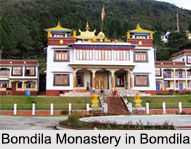 Bomdila is the headquarters of the West Kameng district, located in the north-western part of the state of Arunachal Pradesh. It is set amongst the mighty Himalayan Mountain Ranges at an average elevation of 2,415 metres. Bomdila is known for its scenic terrain, along with its Buddhist monasteries and apple orchards.
Bomdila is the headquarters of the West Kameng district, located in the north-western part of the state of Arunachal Pradesh. It is set amongst the mighty Himalayan Mountain Ranges at an average elevation of 2,415 metres. Bomdila is known for its scenic terrain, along with its Buddhist monasteries and apple orchards.
History of Bomdila
It is believed that during the medieval times, Bomdila was part of the Tibetan kingdom. The few recorded facts also suggest that Bomdila was watched over and ruled by the local tribesmen and the tribal rulers from Bhutan from time to time. During this period, the Ahom rulers from Assam did not indulge with local tribes, except for retaliatory raids.
In the year 1873, the region of Bomdila in Arunachal Pradesh was declared by the British as off-limits, which remained a disputed region between India and China after the independence of India. Though the Chinese invaded the area around Bomdila in 1962, but they later retrieved their troops from this region.
Demographics of Bomdila
As per the reports of Census India 2011, the Bomdila circle is known to be the third most populous sub district of West Kameng district with a population of about 9,792. Out of the total population, the percentage of male is 52% while the female percentage is lesser than the male and is of 48%. The population of children between the ages of 0 to 6 years is about 11% with the boys being 49% while the girls are 51%. The population of this region has increased by 25% in the last decade. Bomdila is inhabited by the tribal communities of Monpa, Sherdukpen, Miji, Bugun and Aka.
Climate of Bomdila
Bomdila has an alpine type of climate with the maximum temperature during summers being about 32° C, while the lowest temperature measured is 20° C. During the summer season, June is the hottest month in this region. The winters here are chilly and commences from the month of December till the month of February. The minimum temperature during these days is 11° C and the maximum temperature is about 26° C. Bomdila receives frequent rainfall and the monsoons prevail from the months of July to September. The scenic beauty of the region is at its best during the monsoon season.
 Nearby Attractions in Bomdila
Nearby Attractions in Bomdila
Tourism is new to Bomdila because of lack of infrastructure of roads in Northeast India. The picturesque landscape and the panoramic views of the mountains surrounding this place make it a place worth visiting. Listed below are some of the tourist attractions in Bomdila.
The Bomdila Monastery: One of the primary attractions in Bomdila, this monastery is also popularly known as the Gentse Gaden Rabgyel Lling monastery. Built by the 12th reincarnate of Tsong Gontse Rinpoche, the people in this monastery called the Monpas, practise Mahayana Buddhism. The Bomdila Monastery is also popular for being a replica of Tibet"s Tsona Gontse Monastery.
The Eaglenest Wildlife Sanctuary: Located in the Himalayan foothills, this wildlife sanctuary derives its name from the Red Eagle Division of the Indian army. It is known to be a prime birding site due to the extraordinary variety, numbers and accessibility of species. The sanctuary is home to at least 454 species of birds including a wide variety of herpetofauna and at least 34 species of amphibians. This wildlife sanctuary also provides habitat to clouded leopard, marbled cat, endangered capped langur, red panda, Asiatic black bear, the Arunachal macaque and the gaur.
Bomdila Viewpoint: This is one of the most visited places in Bomdila because of its magnanimous view of the entire West Kameng Valley. From the highest point, people can view the roads leading to Tawang and Bhutan and the Nechipu Pass.
Craft Centre and Ethnographic Museum: This craft centre produces fine carpets of beautiful designs and masks. This place showcases the rich culture and heritage of Bomdila. A variety of carpets including the Buddhist Thangkas also known as wall hangings and handicrafts along with masks are produced and displayed here. The dragon design carpets are the major attraction of the museum.
Other than these, the apple orchards stretched across vast lands are also a major source of tourist attraction.
Visiting Information on Bomdila
Bomdila is located in a remote part of India and does not have an airport or railway station of its own. The nearest airport is at Tezpur in Assam and the Rangapara railway station is at a fair distance of 146 km away from Bomdila. It is connected by road with other towns in Arunachal Pradesh and Assam. It can be reached from the town of Tezpur by local bus or any other kind of available transportation.



















